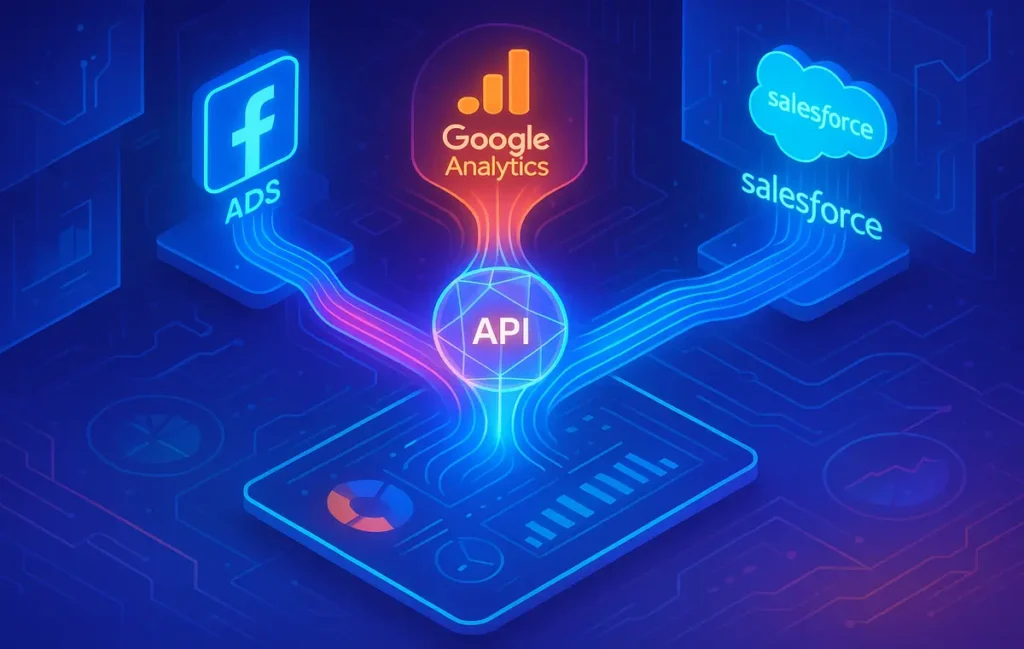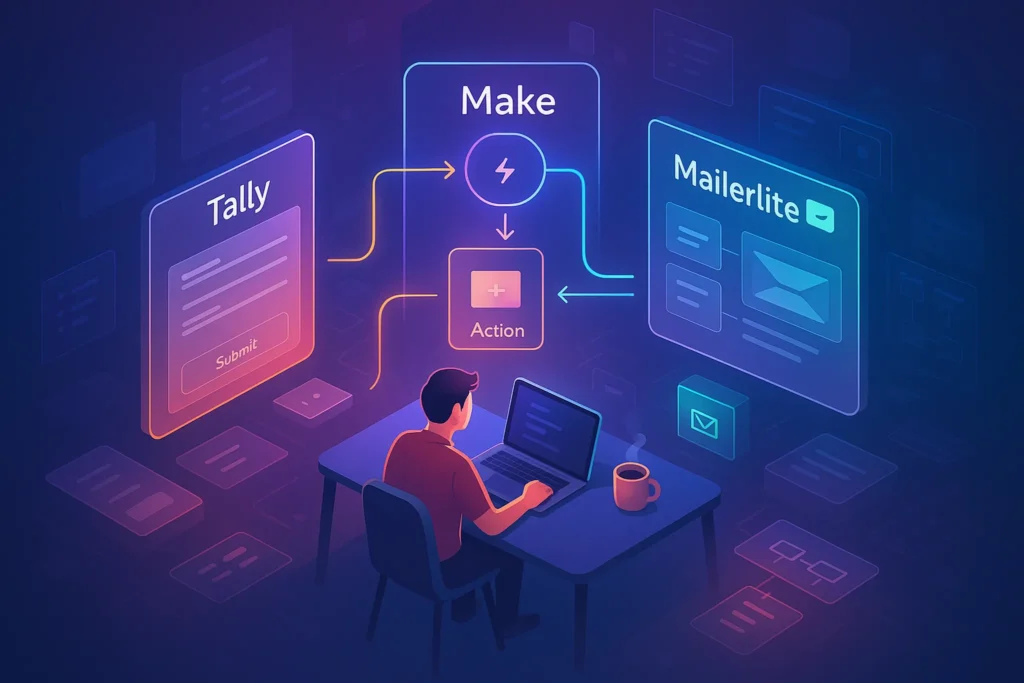🎯 Intro
Picture this: your Facebook Ads data lives in one silo, your Google Analytics numbers in another, and your CRM sales records in yet another. Your marketing team spends hours exporting spreadsheets, trying to make sense of what actually worked. Did that ad campaign drive conversions—or did attribution fail somewhere along the way?
This is the everyday chaos of fragmented data. Marketing API integrators are designed to end it. Unlike consumer-friendly automation apps that connect tools with a few drag-and-drop rules, API integrators build robust pipelines between advertising platforms, analytics suites, and CRMs. For companies that crave a unified view of their customer journey, this is the missing puzzle piece.
If you’re new to the broader automation landscape, remember this piece sits above drag-and-drop tools; for the task-level stuff and a quick refresher on the basics, see our guides Workflow Automation 101 and Top 10 Automation Tools for Marketers—this article focuses on the integration layer that unifies data, not just triggers actions.
🔍 What Are Marketing API Integrators?
At the simplest level, an API (Application Programming Interface) is the language software uses to talk to each other. A Marketing API integrator specializes in stitching together data across ad networks (like Google Ads, Meta Ads, LinkedIn), analytics platforms (Google Analytics, Mixpanel, Adobe Analytics), and CRMs (Salesforce, HubSpot, Zoho).
Unlike Zapier, IFTTT, or other consumer-focused automation tools that trigger actions, integrators are designed for data unification. Think of Zapier as a “postman” that passes simple messages, while API integrators are “data architects,” creating a structured, automated data pipeline that powers reporting, attribution, and personalization.
This layer is more technical and often overlooked by SMBs. But as customer journeys span multiple platforms, the need for accurate data stitching has become non-negotiable.
If you’re evaluating where this fits in your stack, think of it as the connective tissue between ad platforms, analytics, and CRM, while your task automations live elsewhere; for a practical overview of those day-to-day tools and setups, check Best Workflow Automation Tools for Solopreneurs & Remote Teams.
⚡ Why They Matter for Ads + Analytics + CRM
Marketing today is a multi-channel warzone. You’re running Facebook Ads, retargeting on Google, experimenting with TikTok campaigns, and capturing leads through landing pages. Each system measures results differently. Without integration, attribution becomes guesswork.
For SMBs, the result is wasted ad spend and flawed decision-making. For enterprises, the stakes are even higher: inaccurate attribution can cost millions. With API integrators, all campaign data flows into a single dashboard. This means you can finally see whether an ad click led to a sale, and which touchpoint mattered most.
Even more powerful is the feedback loop into CRMs. Instead of segmenting audiences blindly, you can feed accurate purchase history, campaign response, and engagement metrics into your CRM. This enables true personalization—sending the right message to the right lead at the right time.
Solopreneurs often feel this pain even more because they run multi-channel campaigns with limited time; if that’s you, pair this integration strategy with targeted tools from How to Use Niche Automation Tools to Scale as a Solopreneur to keep your workload lean while your data stays trustworthy.
💡 Nerd Tip: Before buying any integrator, check if your ad or CRM platforms already offer native integrations. Sometimes the simplest solution is already in your stack.
🛠️ Key Marketing API Integrators in 2025
Several platforms dominate this space, each with strengths and trade-offs.
-
Funnel.io – Known for its no-code interface and wide library of connectors. Perfect for marketing teams that want fast dashboards without heavy engineering.
-
Supermetrics – Popular with agencies, thanks to its deep Google Sheets and Data Studio integrations. Great for lightweight reporting pipelines.
-
Improvado – Offers enterprise-level customization with strong support for large data sets. Tailored for organizations needing complex transformations.
-
Segment (Twilio) – More than an integrator; it’s a Customer Data Platform that routes behavioral data across your stack. Essential for companies focused on personalization.
-
Stape.io (Server-side GTM) – A rising player for server-side tracking, enabling cleaner data flows and better privacy compliance.
Each tool balances ease of use with technical power. Funnel and Supermetrics shine for marketing teams without engineering support, while Segment and Improvado appeal to data-driven enterprises.
These integrators shine when they’re paired with tactical, creator-friendly automations; for examples you can deploy this week—think scraping, enrichment, and fast reporting loops—browse Top Automation Workflows with HARPA AI and layer those wins on top of your unified data pipeline.
📈 Real ROI Breakdown
The value of API integrators isn’t theoretical—it’s measurable. Companies adopting these tools report:
-
30–50% reduction in time spent on manual reporting by automating data pulls.
-
20–25% increase in attribution accuracy by ensuring all ad and CRM touchpoints are connected.
-
Up to 15% boost in campaign ROI by feeding unified data back into personalization engines.
Instead of paying analysts to wrangle spreadsheets, marketing teams spend more time optimizing campaigns and less time cleaning data. For SMBs, this means getting more from limited budgets. For enterprises, it means maximizing efficiency at scale.
🚀 Implementation Guide
Getting started with API integrators requires a structured approach.
Before you map the stack, align your expectations: this isn’t about building dozens of tiny zaps; it’s about creating a durable data backbone that feeds every decision. If you still need to shore up your task layer first, skim Top 10 Automation Tools for Marketers and Best Workflow Automation Tools for Solopreneurs & Remote Teams, then come back here to architect the integration layer.
Step 1: Map Your Stack. List all your ad platforms, analytics tools, and CRMs. Identify overlaps and gaps.
Step 2: Identify Missing Links. Where does data stop flowing? For example, are Facebook leads reaching your CRM instantly, or days later?
Step 3: Pick the Right Integrator. Match your needs to the tool. If your team works in Google Sheets daily, Supermetrics is natural. If you need enterprise CDP-level routing, Segment is the answer.
Step 4: Test With One Campaign. Don’t boil the ocean. Start with one campaign pipeline and validate the flow.
Step 5: Scale Multi-Channel. Once tested, expand across all campaigns and ensure monitoring is in place.
💡 Nerd Tip: Always start with one use case—like connecting Google Ads to Salesforce—before scaling across all platforms.
⚠️ Challenges & Solutions
Even with powerful tools, integration isn’t frictionless.
-
API Limits and Costs: Some platforms throttle requests, leading to delays or unexpected bills. Solution: optimize queries and monitor usage carefully.
-
Data Privacy (GDPR/CCPA): Sending customer data across systems raises compliance concerns. Choose vendors with enterprise security certifications.
-
Complex Setup: Non-technical teams may struggle. The solution: start with no-code tools or hire a technical partner for initial implementation.
Remember, integration is as much about people as it is about tech. Training your team to trust and use the data is part of the rollout.
A final word on sequencing: don’t conflate data unification with everyday automations. Keep this layer clean, compliant, and scalable—and let your tactical workflows evolve separately. For a quick reset on fundamentals and stack hygiene, revisit Workflow Automation 101 before you scale to multi-channel attribution.
⚡ Ready to Unify Your Marketing Data?
Stop juggling spreadsheets. Funnel your ads, analytics, and CRM data into one dashboard with tools like Funnel.io or Supermetrics. Smarter attribution, faster insights, better results.
📚 Case Studies & Real-World Scenarios
It’s one thing to explain what integrators do—it’s another to see them in action. Consider a mid-sized e-commerce store spending $50,000/month on ads. Before adopting Supermetrics, their marketing manager spent up to 15 hours weekly exporting CSV files from Google Ads and Facebook, then reconciling with Shopify sales. After implementation, reports updated automatically every morning, cutting manual work by 80%.
Or take a SaaS company using Segment. By routing sign-up and churn events directly into their CRM and ad platforms, they discovered that one ad channel generated higher lifetime value despite fewer sign-ups. This insight saved them from doubling down on vanity metrics and instead shifted budget to channels that actually retained users. These stories highlight why integrators aren’t just “nice-to-haves” but competitive advantages.
📊 Comparison Mini-Table of Leading Integrators
Sometimes readers want a bird’s-eye view. Here’s a simple breakdown of three major players:
| Tool | Best For | Strengths | Limitations | Pricing Level |
|---|---|---|---|---|
| Funnel.io | SMBs & Agencies | Wide connector library, simple UI | Less flexible for custom transformations | $$ |
| Supermetrics | Agencies & Data-Driven SMBs | Tight Google Sheets/Data Studio link | Heavy use can slow spreadsheets | $ |
| Improvado | Enterprises & Complex Stacks | Handles large-scale transformations, strong support | Higher cost, longer setup | $$$ |
💡 Nerd Tip: Use such tables not as final verdicts but as orientation. The best tool depends on your budget, team size, and data maturity.
🔮 Future Trends in API Integrations
The world of marketing data is shifting rapidly. API integrators are evolving from simple connectors into data orchestration platforms. Three trends stand out:
-
Server-Side Tracking: With browser cookies dying, server-side connections (like Stape.io) ensure cleaner, privacy-friendly data flows.
-
Cookieless Attribution: Integrators are embedding probabilistic modeling to fill attribution gaps left by privacy changes.
-
AI-Driven Data Enrichment: Imagine CRMs that don’t just sync customer data but enrich it with predictive insights—like purchase probability or churn risk.
This trajectory means integrators will no longer just “move data.” They’ll actively improve it. Companies that adopt early will enjoy better attribution and smarter personalization before competitors catch up.
🔒 Security & Compliance Concerns
Whenever data crosses systems, compliance questions arise. How does personal data from CRMs move safely into ad networks? The answer lies in GDPR/CCPA-aware design. Leading integrators encrypt data in transit and at rest, while offering audit logs and role-based permissions.
For industries like healthcare or finance, this isn’t optional. If you’re connecting Salesforce Health Cloud data into a Google Ads campaign, you must prove compliance. That’s why integrators increasingly highlight their SOC 2, ISO 27001, or HIPAA certifications. Choosing a vendor without such compliance can expose your brand to legal and reputational risks.
🏗️ Stack Strategy & Layering
It’s tempting to think of integrators as replacements for automation tools—but they operate on different layers. A modern marketing stack usually looks like this:
-
Task Automation Layer: Tools like Zapier, IFTTT, or Top Automation Workflows with HARPA AI handle simple triggers (send email when lead captured).
-
Data Integration Layer: API integrators like Funnel, Supermetrics, and Segment unify and transform marketing data at scale.
-
Analytics & BI Layer: Visualization platforms like Looker, Power BI, or Tableau present the integrated data in dashboards for decision-making.
Understanding this hierarchy helps teams avoid overlap and maximize ROI. Instead of overloading Zapier with heavy data tasks or forcing BI tools to clean messy inputs, each layer plays its role. The result is a marketing stack that’s resilient, scalable, and transparent.
📬 Want More Smart Automation Insights?
Join our free newsletter and get weekly insights on automation tools, AI workflows, and data-driven marketing—delivered straight to your inbox. No fluff. Just practical strategies from NerdChips.
🔐 100% privacy. No noise. Just automation tips from NerdChips.
🧠 Nerd Verdict
API integrators represent the next level of marketing automation. Where tools like Zapier handle task-level workflows, these platforms unify the data foundation itself. For any company serious about customer journeys, attribution, and personalization, they are no longer optional.
The biggest win? Marketing teams finally stop arguing about whose numbers are right—and start acting on a single source of truth.
❓ FAQ: Nerds Ask, We Answer
💬 Would You Bite?
If you could see every ad click, CRM update, and analytics event in one place—
would you finally trust your data enough to scale faster?
Crafted by NerdChips for creators and teams who want their best ideas to travel the world.



